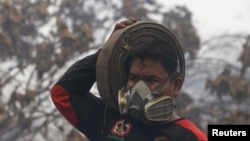Researchers say a thick haze caused by man-made forest fires in Indonesia is the likely cause of more than 100,000 deaths.
The pollution also has been blamed for deaths in nearby Malaysia and Singapore. The haze has hurt relations between Indonesia and its neighbors.
Scientists from Harvard and Columbia Universities used a complex method to estimate the number of deaths from the haze. The number of deaths is far greater than the Indonesian government’s official number of 19 deaths.
Researchers estimated there were 91,600 deaths in Indonesia, 6,500 deaths in Malaysia and 2,200 in Singapore.
The fires in Indonesia last year were the worst since 1997.
Each year, fires are set in Indonesia's forests and in peat areas. Peat is a collection of dead plants. Burning is a fast and low-cost way to clear peat areas and land for palm oil and pulpwood production.
Rajasekhar Bals is an environmental engineering expert at the National University of Singapore. He told the Associated Press the study could be a "wake-up call" for Indonesia. He added that the country should take action to stop the fires. Bals said there must be cooperation throughout the area to deal with public health problems caused by the fires.
The activist group, Greenpeace, said the study is "groundbreaking." The organization known for protecting the environment also cautioned that the new numbers represent a "conservative estimate."
The study did not include the impact the haze has on children and future generations.
Nursyam Ibrahim is from the Indonesian Medical Association's West Kalimantan chapter. He told the media how Indonesian health workers have been overworked by the haze.
The study is to be published in the journal Environmental Research Letters.
I’m Caty Weaver.
The staff at VOA News wrote this story. Jim Dresbach adapted it for Learning English. Mario Ritter was the editor.
We want to hear from you. Write to us in the Comments Section or visit our Facebook page.
________________________________________________________________
Words in This Story
haze – n. dust, smoke, or mist that has filled the air so that you cannot see clearly
peat – n. a dark material made of decaying plants that is burned for heat or added to garden soil
palm oil – n. oil that is obtained from the fruit of some palm trees and used in cooking and in making soap and other products
pulpwood – n. wood suitable for making into pulp for making paper
groundbreaking – adj. introducing new ideas or methods
wake-up call – n. something that makes you fully understand a problem, danger or need







